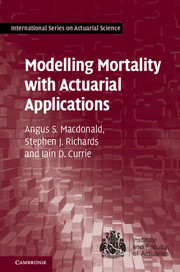Refine search
Actions for selected content:
2703 results in General statistics and probability

Modelling Mortality with Actuarial Applications
-
- Published online:
- 28 April 2018
- Print publication:
- 03 May 2018

Predictive Statistics
- Analysis and Inference beyond Models
-
- Published online:
- 27 April 2018
- Print publication:
- 12 April 2018
Preface
-
- Book:
- Predictive Statistics
- Published online:
- 27 April 2018
- Print publication:
- 12 April 2018, pp xi-xiv
-
- Chapter
- Export citation
Part I - The Predictive View
-
- Book:
- Predictive Statistics
- Published online:
- 27 April 2018
- Print publication:
- 12 April 2018, pp 1-2
-
- Chapter
- Export citation
2 - Defining a Predictive Paradigm
- from Part I - The Predictive View
-
- Book:
- Predictive Statistics
- Published online:
- 27 April 2018
- Print publication:
- 12 April 2018, pp 34-66
-
- Chapter
- Export citation
10 - Blackbox Techniques
- from Part III - Contemporary Prediction
-
- Book:
- Predictive Statistics
- Published online:
- 27 April 2018
- Print publication:
- 12 April 2018, pp 361-448
-
- Chapter
- Export citation
Frontmatter
-
- Book:
- Predictive Statistics
- Published online:
- 27 April 2018
- Print publication:
- 12 April 2018, pp i-iv
-
- Chapter
- Export citation
Expanded Contents
-
- Book:
- Predictive Statistics
- Published online:
- 27 April 2018
- Print publication:
- 12 April 2018, pp vi-x
-
- Chapter
- Export citation
Part III - Contemporary Prediction
-
- Book:
- Predictive Statistics
- Published online:
- 27 April 2018
- Print publication:
- 12 April 2018, pp 359-360
-
- Chapter
- Export citation
Index
-
- Book:
- Predictive Statistics
- Published online:
- 27 April 2018
- Print publication:
- 12 April 2018, pp 635-642
-
- Chapter
- Export citation
9 - Model Selection
- from Part II - Established Settings for Prediction
-
- Book:
- Predictive Statistics
- Published online:
- 27 April 2018
- Print publication:
- 12 April 2018, pp 307-358
-
- Chapter
- Export citation
Contents
-
- Book:
- Predictive Statistics
- Published online:
- 27 April 2018
- Print publication:
- 12 April 2018, pp v-v
-
- Chapter
- Export citation
5 - Time Series
- from Part II - Established Settings for Prediction
-
- Book:
- Predictive Statistics
- Published online:
- 27 April 2018
- Print publication:
- 12 April 2018, pp 125-160
-
- Chapter
- Export citation
12 - The Future of Prediction
- from Part III - Contemporary Prediction
-
- Book:
- Predictive Statistics
- Published online:
- 27 April 2018
- Print publication:
- 12 April 2018, pp 524-604
-
- Chapter
- Export citation
6 - Longitudinal Data
- from Part II - Established Settings for Prediction
-
- Book:
- Predictive Statistics
- Published online:
- 27 April 2018
- Print publication:
- 12 April 2018, pp 161-205
-
- Chapter
- Export citation
1 - Why Prediction?
- from Part I - The Predictive View
-
- Book:
- Predictive Statistics
- Published online:
- 27 April 2018
- Print publication:
- 12 April 2018, pp 3-33
-
- Chapter
- Export citation
3 - What about Modeling?
- from Part I - The Predictive View
-
- Book:
- Predictive Statistics
- Published online:
- 27 April 2018
- Print publication:
- 12 April 2018, pp 67-85
-
- Chapter
- Export citation
References
-
- Book:
- Predictive Statistics
- Published online:
- 27 April 2018
- Print publication:
- 12 April 2018, pp 605-634
-
- Chapter
- Export citation
Part II - Established Settings for Prediction
-
- Book:
- Predictive Statistics
- Published online:
- 27 April 2018
- Print publication:
- 12 April 2018, pp 123-124
-
- Chapter
- Export citation
8 - Nonparametric Methods
- from Part II - Established Settings for Prediction
-
- Book:
- Predictive Statistics
- Published online:
- 27 April 2018
- Print publication:
- 12 April 2018, pp 249-306
-
- Chapter
- Export citation
